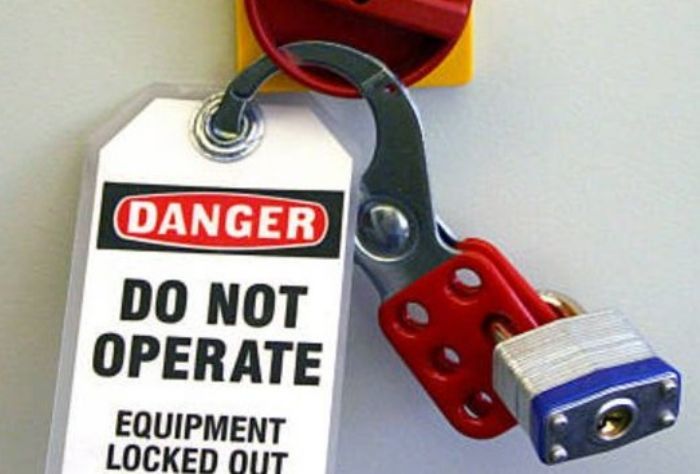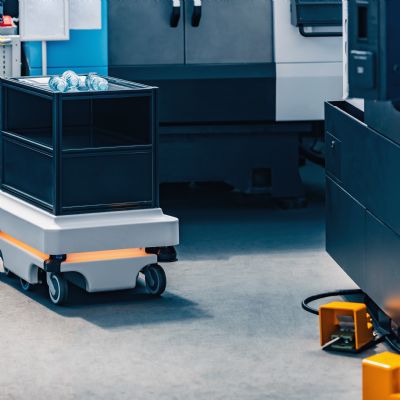In the Judge’s words:
“On April 19, 2021, an industrial appeals judge certified that the parties agreed to include the Jurisdictional History in the Board on record solely for jurisdictional purposes. On September 22, 2020, in Yakima County, WA, Jeff Holeman, a maintenance employee for Cintas Corp., incurred an industrial injury when the tip of his left thumb was amputated when it became caught in a moving part of a steam tunnel belt.
“Prior to the accident, Mr. Holeman performed LOTO of the machine in order to remove the cover to the electrical motor. Mr. Holeman then reenergized the machine and ascended a portable ladder to perform an electrical check using a voltmeter. Upon completion of the electrical check, Mr. Holeman reengaged LOTO and reassembled the cover to the motor. After descending the ladder, he again reenergized the machine, then went back up the portable ladder to make one last troubleshooting observation. He was startled when the machine started, resulting in his hand moving forward into the moving part of the belt and the amputation of the tip of his left thumb.
“At the time of the injury, Mr. Holeman was merely observing the operation of the machine. He was not performing hands-on maintenance or testing of the motor and did not intend or attempt to place any body part into the point of operation of any hazardous area created by the machine. The rotating or revolving parts that created the hazard in question are safeguarded by a height of more than 7 ft. vertically.”
In his opinion concerning the vertical safeguarding-by-distance of machine parts, Judge Johnson rejected the department’s attempt to change the standard by adding a new horizontal guarding requirement whenever temporary stepladders are used to observe machinery located 7 ft. or more vertically above the working floor.
“The department would have the code provision interpreted so broadly that any time a worker is using a portable ladder (or presumably any other sort of stool, lift, or portable access device) the safeguarding-by-distance requirements are not met and some alternate guarding must be provided. Cintas correctly points out such a reading and interpretation would render the safeguarding-by-distance code provision ineffective since any and all moving parts can presumably be accessed by some sort of portable ladder or lift device. The rule is obviously intended to protect the inattentive and unwary from rotating or moving parts in routine and ordinary workspaces. It would be a stretch to say it applies everywhere else where work may be performed using some portable means of access such as a ladder, lift or stool. Otherwise, the 7-ft. rule does not make sense, and all rotating and moving parts must be guarded.”
Former Cleveland OSHA area office director Rob Medlock was
our defense expert. The Judge considered
these points from his testimony:
“Mr. Medlock is an experienced OSHA safety and health officer who had conducted inspections of workplace to determine whether they are following federal standards. He reviewed the witness statements along with the Colmac Manual for purposes of his expert evaluation of this case. In his opinion, the LOTO procedure for the Colman steam tunnel was compliant under the circumstances. The sequence of events was that Mr. Holeman observed the operation without doing any maintenance on it. He then went down and locked the machine out and went back up and removed the cover to access the electrical connections. He went down and energized machine and got his personal protective equipment on and went up to test the motor. When that was completed, Mr. Holeman went down and locked it out again, then went back up and replaced the cover. After that, he came back down and reenergized it. Finally, he ascended the stepladder to observe if everything was operating and that is when he hit his back, reacted, and got the tip of his thumb amputated. A live electrical work permit was obtained even though that is not required. Likewise, there is no formal requirement that someone do a checklist for LOTO, but that is a good practice.
“According to Mr. Medlock, the LOTO standard has certain exemptions and requirements. One is that if you are required to place any body into the point of operation, the machine needs to be locked out. At the time of the injury, Mr. Holeman was not anticipating doing that, so his actions were proper. It was a very unfortunate accident, but he was just going up there for visual observation. He was not anticipating reaching out into the point of operation. The fact of an accident does not establish the occurrence of an OSHA violation.”
Technologies: Safety
 Earlier this year, Ehlke Law Offices, along with co-counsel attorneys from Chicago’s Seyfarth Shaw LLP, received Judge Daniel Johnson’s proposed decision and order (PD&O) vacating lockout-tagout (LOTO) and machine-guarding citations and penalties against OH-based Cintas Corp. This PD&O ruling came in the Yakima case of In re: Cintas Corporation No 3/Cintas Uniform, BIAW Docket No. 21 W1034.
Earlier this year, Ehlke Law Offices, along with co-counsel attorneys from Chicago’s Seyfarth Shaw LLP, received Judge Daniel Johnson’s proposed decision and order (PD&O) vacating lockout-tagout (LOTO) and machine-guarding citations and penalties against OH-based Cintas Corp. This PD&O ruling came in the Yakima case of In re: Cintas Corporation No 3/Cintas Uniform, BIAW Docket No. 21 W1034. 







